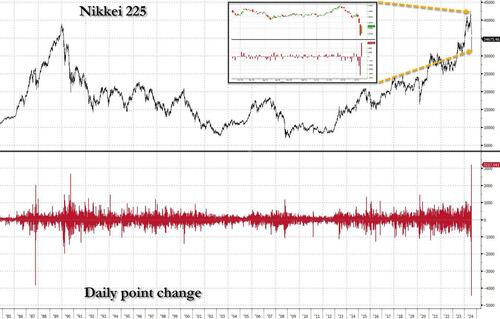
Japan Rushed To Calm Markets, Trigger Buying Spree With Emergency Central Bank Meeting
Late on Sunday (Monday morning Japan time) as Japan’s stock were disintegrating, its largest bank crashing the most on record, we asked – somewhat sarcastically but not really – what time „the emergency BOJ/MOF meeting” (that stabilizes the „market” and telegraphs the next bailout) would take place:
What time is the emergency BOJ/MOF meeting
— zerohedge (@zerohedge) August 5, 2024
While that may have been a joke, the subsequent panicked response was all too real and on Tuesday (local time), just as Japanese markets were opening with the Nikkei set for its biggest point gain on record and soaring 10% after tumbling 12% the previous session…

… Japanese leaders rushed on Tuesday to ease fears about the ongoing crash and sharp swings in the country’s financial markets, and announced a – drumroll – emergency meeting between the Bank of Japan, Ministry of Finance, and Financial Service Agency for 3pm that day (just before the close to prevent random selling and shorting ahead of what could well have been the announcement of another market bailout and resulting face-ripper) to „discuss the market sell-off” and with the prime minister urging calm.
Just as we predicted they would, the executives from Japan’s Ministry of Finance, the Financial Services Agency and the Bank of Japan (BOJ) held the trilateral meeting on Tuesday afternoon, said Atsushi Mimura, the country’s top currency diplomat, emphasising close coordination between the government and the central bank.
„The government and the BOJ agreed that it is important to monitor developments in economic and financial markets domestic and abroad with a sense of urgency while calmly assessing what is happening,” Mimura told reporters after the meeting.
As Reuters notes, the gathering is typically held in times of market turbulence, partly as a gesture that authorities are willing to act. A similar meeting was last held on March 27 this year following a sharp decline in the value of the yen.
The mere news of the meeting – where anything could have been announced, a rate cut, even a boost in QE, one never knows with the BOJ cartoons – was enough to halt the selling, and the Nikkei soared in a relief rally after plummeting 12.4% on Monday, its biggest percentage drop since the 1987 Black Monday crash. It ended Tuesday’s trade up 10.2% at 34,675.46.
Mimura declined to comment on factors driving the stock plunge but said the three parties shared a view that the Japanese economy will continue to gradually recover.
At the same time, Japanese Prime Minister Fumio Kishida – who until recently was chastising the central bank for allowing the yen to crater to record lows only to realize that the offset to a stronger yen is a crashing stock market – urged caution, saying it was important to make calm judgements about the market. He offered an optimistic outlook for the world’s fourth largest economy, citing factors such as the first rise in inflation-adjusted real wages in more than two years in June.
„We recognise the Japanese economy continues to make a strong transition to a new stage,” Kishida told reporters in Hiroshima earlier on Tuesday.
Japanese Finance Minister Shunichi Suzuki said the government would monitor and analyse financial market moves and work closely with relevant authorities, including the BOJ.
„It’s important to realize resilient economic growth while responding to changes in front of us,” Suzuki said, clearly joking since the last thing Japan has to look forward to is „resilient economic growth”, and thus the only thing it does have to look ahead to is a weaker yen (and stronger marke), which is also why as Bloomberg reported separately, the Bank of Japan’s monetary policy tightening last week „triggered a wave of criticism after it appears to have helped set off a historic plunge in Japanese stocks and contributed to global market turmoil — likely putting any plans for further interest-rate hikes on ice.”
“The BOJ needs to be humble about economic data and the markets,” said Nobuyasu Atago, chief economist at Rakuten Securities Economic Research Institute and a former BOJ official. “The fact that the BOJ raised interest rates in the face of poor economic statistics shows that it did not pay attention to data.”
Or, as we put it, if in doubt what the BOJ will do, you can assume with 100% certainty it will be the dumbest possible thing.
BOJ preview: whatever is the dumbest possible thing that can happen, is what will happen. 100% guaranteed
— zerohedge (@zerohedge) July 30, 2024
We were proven right once again: BOJ Governor Kazuo Ueda last week repeatedly stressed the BOJ decided to increase rates based on economic and inflation data showing that developments were in line with previous expectations. He also said rates would keep rising as long as that trend held. But the worst equity selloff in decades now has analysts beginning to think the central bank pulled the trigger too early. Many are changing expectations.
“It was a poorly timed interest-rate hike,” said Mari Iwashita, chief market economist at Daiwa Securities Co. “The BOJ will have to wait and see whether the US economy will enter a recession or a soft landing before it can make the next move. At the very least, a September, October rate hike is now off the table.”
The BOJ’s July 31 decision helped the yen rebound from a multi-decade low, something that had crushed Japanese consumers’ purchasing power as it boosted imported inflation. But now the currency’s rapid surge — up 8% against the dollar in the past week — is hammering earnings prospects for exporters, sparking fears of a new deflationary shock and causing equities to tumble. Because, as we have explained repeatedly before, Japan is doomed, and it can’t prop up its currency, its bonds and its stocks at the same time, and the longer it delayed picking one, the greater the inevitable eventual disaster.
Some speculated, for obvious reasons, that political pressure was involved in the BOJ’s decision to make a dramatic U-turn and catastrophic policy error.
“I can’t help but think that political factors were behind the decision,” said Atago. “I have no choice but to interpret this as a sign of communication between politics and the BOJ on how to deal with the weak yen.”
Atago said consumption and production data were too weak to justify a rate increase. Consumer spending in real terms has shrunk in each of the four quarters to March as inflation ate into people’s purchasing power.
That, however, matters little when political lives are on the line: two senior politicians in Japan’s ruling party made the rare move of weighing in on BOJ policy last month, in the run-up to the decision. Heavyweight Toshimitsu Motegi said the BOJ should more clearly show its intention to normalize policy, while cabinet member Kono Taro spoke out against the weak yen while discussing the BOJ. The two are seen as potential candidates for the ruling Liberal Democratic Party’s leadership race in September, coming around the time of the BOJ’s next policy decision.
The comments showed how the political calculus has shifted notably over time. Back during the era of deflation, politicians had put pressure on the central bank to ease policy and to hold off on tightening. Former Prime Minister Shinzo Abe publicly said in 2014 that the government had opposed the end of quantitative easing in 2006 and the scrapping of zero interest-rate policy.
Well, they got what they want, and now they also have the market crash that goes with it, and the far bigger loss in votes that such a collapse in net worth entails. Indeed, on Tuesday Prime Minister Fumio Kishida said he’s watching market developments with a sense of urgency and that the government will continue to cooperate closely with the BOJ. Until last week he was only watching yen moves. Which is why, as we also predicted last week, we are confident that it’s only a matter of time before the market calls the BOJ’s bluff, resumes its plunge, and forces the BOJ to reverse its catastrophic rate hike.
Who will cut first: BOJ or Fed
— zerohedge (@zerohedge) August 2, 2024
And that’s not just our view: as we discussed last night, Goldman’s own traders said that after the „Perfect Storm In The Vol Market… We Are About To Enter The Central Bank Response Phase.” And before it finally stabilizes, the market will demand much more from central banks than just more jawboning and theatrical meetings where nothing is decided.
Tyler Durden
Tue, 08/06/2024 – 11:02








![Gwiazdorska akcja! Tak został bohaterem mistrza Polski [WIDEO]](https://sf-administracja.wpcdn.pl/storage2/featured_original/6824efab5a55d6_10990741.jpg)





